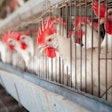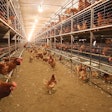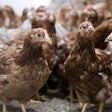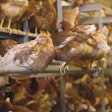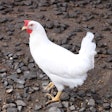The situation with highly pathogenic avian influenza (HPAI) in Nigeria is a continuing cause for concern. Within the last two weeks, the veterinary authorities have reported to the World Organisation for Animal Health (OIE) a further 42 outbreaks in which the H5N1 subtype of the virus has been confirmed. These have affected more than 140,000 birds – mainly layer or pullet flocks - in 9 states. Spread of the infections is attributed to poor farm biosecurity.
Interviewed at the end of January by Punch, the registrar and CEO of the Nigerian Institute of Animal Science, Dr. Godwin Oyedeji, said that at least 2.5 million chickens have been infected and over 700 farms in 18 states have been affected nationwide.
Burkino Faso, where HPAI outbreaks occurred last year, has not reported any new cases since July.
Situation in Asian poultry
A backyard flock of just over 3,000 birds has been confirmed with the H5N6 subtype of the HPAI virus in Nghe An province in central Vietnam.
Bangladesh has reported its first cases of HPAI since June 2014. The veterinary authority informed the OIE that 40 wild crows found dead in Rajshahi city in early February have tested positive for the H5N1 virus. The state borders India.
The most recent cases of H5N8 HPAI in South Korea were in November 2015. The authorities there consider the situation resolved although epidemiological investigations are ongoing.
Europe: France institutes new health measures
Last week, Minister of Agriculture, Stéphane Le Foll, introduced two orders aimed at eradicating avian influenza from France, targeting the area of waterfowl production in south-western France. It is in this region that a total of 71 outbreaks of HPAI have been confirmed since late November last year, mainly in duck flocks and in eight departments (regions).
The country’s strategy involves continued gradual reduction in poultry populations until May 2nd, 2016, following by a period of restrictions and biosecurity procedures and then controlled re-population. Thereafter, the birds and premises will be subjected to further screening and surveillance.
The secondorder, due to come into effect on July 1st, requires appropriate biosecurity measures to be applied to poultry farms throughout the country. The details will need to be drawn up with expert supervision for each farm, type of livestock and rearing system.
Le Foll stressed the importance of the practical implementation of this eradication strategy to ensure sustainability of France’s poultry sector and the strengthening of trust at European and international levels.
In the United Kingdom, no new cases have been found following the outbreak of low-pathogenic avian influenza (LPAI) in Dunfermline, and so the 1-kilometer restriction zone around the premised has been lifted.
No new outbreaks in U.S. or Mexico
There have been no new outbreaks of LPAI or HPAI in the United States, and increased surveillance has revealed no further virus detections. Cleaning and disinfection are continuing at previously infected premises.
The U.S. Department of Agriculture’s (USDA) Animal and Plant Health Inspection Service (APHIS) is announcing an interim rule that outlines conditions for the payment of indemnity claims relating to HPAI.
Authorities in Mexico, following up on earlier outbreaks of H7N3 HPAI in poultry flocks in the states of Oaxaca and Puebla and of H5N2 HPAI in Sinaloa state Sinaloa reported to OIE that quarantine restrictions were lifted on affected farms last year following cleaning and disinfection of the premises, and an absence of disease following restocking with sentinel birds. Wild birds found dead in Chiapas state in April last year tested positive for the H7N3 virus but there have been no new cases since that time.
China reports 28 new cases of human flu infections
Earlier this month, China’s National Health and Family Planning Commission (NHFPC) has notified the World Health Organization (WHO) of 28 additional laboratory-confirmed cases of human infection with avian influenza A (H7N9) virus, including 5 deaths. The cases started between December 21st, 2015 and January 25th, 2016. Previous contact with live poultry was reported in 25 of the cases.
Cases were reported in 6 provinces and municipalities: Zhejiang (13), Jiangsu (5), Guangdong (4), Fujian (3), Shanghai (2) and Hunan (1).
FluTrackers, an infectious disease news message board, puts the global H7N9 count at 735 cases.
A recent letter to the New England Journal of Medicine reports an unusual cluster of cases of H7N9 influenza in early 2015, indicating that human-to-human transmission of this virus is a possibility. Two physicians treating a patient with influenza in hospital in Shantou, Guangdong province, China, subsequently became infected with the virus. The great majority of patients with the H7N9 strain are known to have had contact with live poultry and it is assumed that is the source of infection.











